#eisenia fetida
Text
A few years prior, I'd been told that tiger worms could be purged and would taste like abalone, the prized shellfish known as paua in New Zealand. They didn't. They tasted like a troll's armpit, an evil flavour borne from something close to the grave. Perhaps the species' name gave a clue as to its palatability: Eisenia fetida. And fetid it tasted. (Apparently even trout find them unpalatable, according to Australia's pre-eminent scientific authority, the CSIRO.)
"Soil: The incredible story of what keeps the earth, and us, healthy" - Matthew Evans
#book quotes#soil#matthew evans#nonfiction#tiger worm#purged#abalone#paua#shellfish#aotearoa#new zealand#troll#armpit#evil#eisenia fetida#fetid#bad taste#trout#unpalatable#australia#csiro
1 note
·
View note
Text
COMPOST: Formación del Oro Negro.
El vermicompost se está volviendo popular y es pordía reemplazar los fertilizantes sinteticos a largo plazo.
DR. IMTIYAZ RASOOL GANAI.
Published on : 17 Apr, 2022, 2:30 pm
(Traducción automatica).
0 notes
Text

#i now have five beautiful individuals of eisenia fetida living in my compost that i keep in the closet#i hope they are enjoying it there and will live happy and fulfilling wormy lives#it would be so cool to be able to turn my food waste into soil that i could give to my houseplants#worm post over
3 notes
·
View notes
Text
Species You Didn’t Know Weren’t Native to North America
There are some species found here in North America that are so common that many people just assume they’re part of the native menagerie. They’re naturalized, which means they’re non-native but have managed to establish reproducing populations here. Some may also be considered invasive, in that they aggressively compete with native species and may even displace them in some places.
I know some of you readers will already be familiar with the fact that the following species aren’t native here. But I bet there’ll be surprises for the rest of you! Let’s see who our not-actually-natives are.

Ring-necked Pheasant (Phasianus colchicus)
Hunters across the continent have long hunted pheasants for the table. First introduced in 1773–exactly 250 years ago–they have since made themselves at home in fields and meadows. While the largest populations can be found in the Midwest, especially the Great Plains states, they can be found throughout the United States, with additional scattered populations in southern Canada and Mexico.
While sometimes assumed to have integrated into their introduced habitats, pheasants actually wreak havoc on native game birds like quail and grouse. They compete for suitable food and nest sites, and may also practice nest parasitism, laying their eggs in other birds’ nests. This competition has led to decreases in native bird populations, as has the spreading of diseases that the pheasants tolerate, but which decimate other species. Pheasants will even attack and kill other birds.
So what other species made the list? Keep reading to find out!
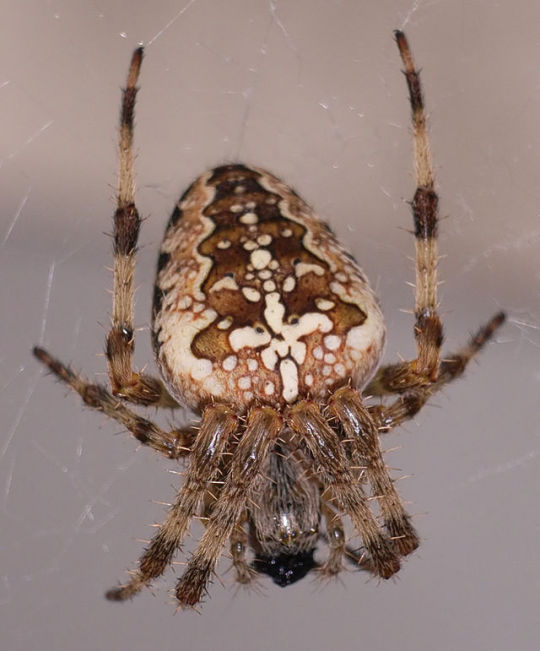
Cross Orb Weaver (Araneus diadematus)
Fall is cross orb weaver time, and I run into these spiders constantly–sometimes literally, depending on how inconveniently their webs are placed! By that time of year, they’ve grown large enough to be noticeable, and their orange and brown coloration looks rather festive.
While I haven’t been able to find any indication that these spiders have a deleterious effect on their introduced ecosystems, they likely put at least some pressure on local invertebrate populations, whether as predators or competitors for prey species. This may become more pronounced as continued overuse of pesticides and habitat loss contribute to the invertebrate apocalypse.
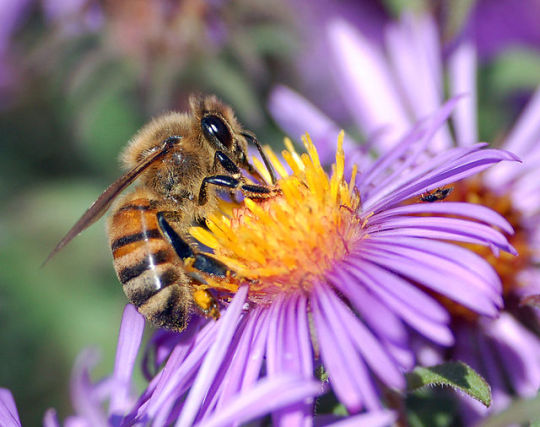
Honey Bee (Apis mellifera)
“Save the bees!” has been an increasingly common headline since Colony Collapse Disorder first became widely known among the general public almost twenty years ago. What the articles rarely mention is that the honey bee is actually a domesticated insect that originated from wild stock in Europe. In fact, the true wild honey bee may be close to extinction, another victim of its domesticated descendants.
In fact, honey bees cause the decline of wild bee species wherever they are introduced. Not only do they compete with wild bees for food and nest sites, but they also spread diseases and parasites to these other species, some of which have become quite scarce. Moreover, honey bees are less effective at pollinating native plants outside their own range, and these species are at risk of extinction if their native pollinators are out-competed.

Another invertebrate beloved of gardeners here, the earthworms actually consist of a mix of both native and non-native species. Unfortunately, many native earthworms went extinct during the last Ice Age, so if your area has a recent glacial history it’s likely that the worms in your garden are invasive. (That does include the red wigglers (Eisenia fetida) commonly used for vermicomposting.)
What damage can a bunch of worms do? Plenty, as it turns out. They speed up decay and mix up nutrients in the soil in ways that many North American ecosystems aren’t used to. This changes physical characteristics of the soil like pH, texture, and density, as well as distribution of nutrients. Some young plants may not be able to reach nutrients that worms have moved deeper underground. So while you may thank earthworms for aerating the soil in your garden, they’re more of a problem for a lot of native ecosystems here.

umbleweed (various species)
“Drifting along with the tumbling tumbleweeds,” sang the Sons of the Pioneers in 1934, though tumbleweeds have been associated with the American West for much longer. Several species of plant dry out, snap off the root system, and roll along the ground spreading the mature seeds. The best-known species is the Eurasian Kali tragus, though there are other species that have been introduced here.
Because these plants take up a lot of physical space, they can crowd out native plants, especially those that are not shade-tolerant. Their seed distribution method means that one plant can spread its descendants many miles from where it originated. Moreover, the masses of dead, dry tumbleweeds can build up and become wildfire fuel.

Red Clover (Trifolium pratense) and White Clover (Trifolium repens)
These two plants are so ubiquitous that it’s easy to assume they’ve always been here. White clover is especially common in lawns, and red clover will pop up in just about any disturbed sunny spot. Both are native to Europe and Asia, and red clover additionally may be found in North Africa. However, both species have been widely introduced elsewhere.
While neither is considered particularly invasive, they can take over large areas of disturbed land. They are deliberately sown for cover crops and livestock forage, so they’re not likely to go away any time soon.
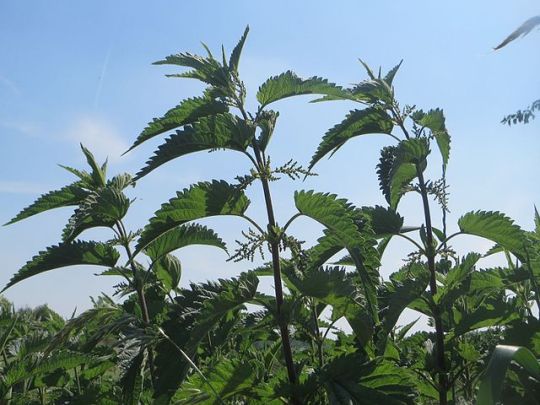
Stinging Nettle (Urtica dioica)
This is one of the most popular spring plants for foragers; chemicals that cause irritation can be removed through soaking the plants in water or cooking them. Although stinging nettle grows well in large areas of the United States, Mexico, and southern and western Canada, it is actually native to northern Africa, Europe, and Asia.
Stinging nettle makes itself at home in forested settings in particular. While it doesn’t create the same sorts of monocultures that, say, Himalayan blackberry does, it can shade out smaller plants with its broad leaves.
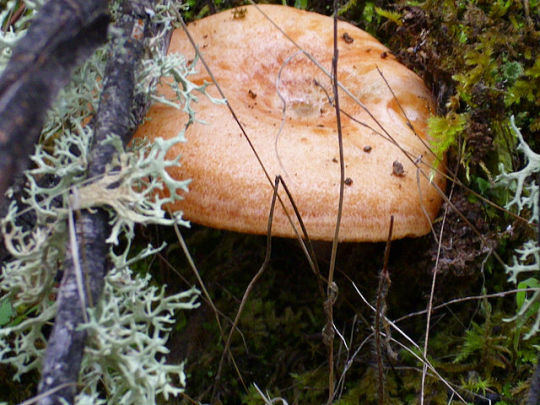
Saffron Milkcap (Lactarius deliciosus)
People don’t often think of fungi when it comes to non-native and invasive species, and yet there are fungi that have been moved around to new areas, often with their partner plants. Some are tiny soil fungi, but there are those that produce visible fruiting bodies. The edible saffron milkcap is one of these. It is mycorrhizal with pine trees in its native Europe, and managed to form connections with pines in North America as well.
As saffron milkcap does not cause any known diseases of plants, it is not considered an invasive species in the way that chestnut blight (Cryphonectria parasitica) is. While the mycelium of saffron milkcap may certainly compete for some of the same soil nutrients as native species in the same area, it has not become aggressive enough to displace native fungi.
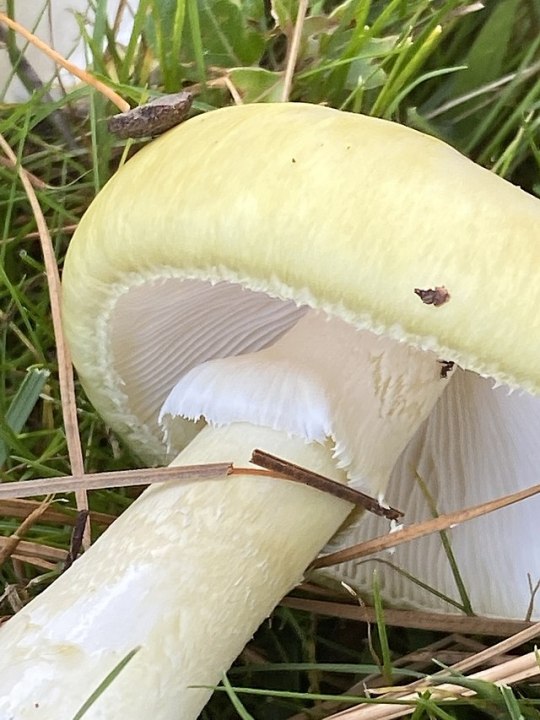
Death Cap (Amanita phalloides)
There are large, white Amanita species native to North America, like A. ocreata and A. bisporigera, both known colloquially as “destroying angels.” The death cap, however, is native to Europe. It has been spreading through parts of the United States, particularly along all the coastlines, and may sometimes be yellow-tinted. Its close cousin, the European destroying angel (A. virosa), has made a few appearances in New England and southern Quebec according to iNaturalist’s map of research-grade observations.
While these invasive Amanitas do not cause widespread ecological damage, they are considered invasive due to their extreme lethality. One cap is sufficient to kill a healthy adult human being.
Did you enjoy this post? Consider taking one of my online foraging and natural history classes or hiring me for a guided nature tour, checking out my other articles, or picking up a paperback or ebook I’ve written! You can even buy me a coffee here!
#CW spider#spider#animals#plants#fungi#wildlife#nature#invasive species#native species#biodiversity#ecology#conservation#environment#gardening#weeds#foraging#mushroom hunting
55 notes
·
View notes
Text
Worm Bin Tutorial

Disclaimer: the information I’m giving is based on my own personal experience and research. Some of the things that work for me may not work in a different setup. If you’re interested in learning more, I’d highly recommend the book “Worms Eat My Garbage” by Mary Appelhof.
Why have a worm bin?
It’s a great way to dispose of organic matter while minimizing methane emissions! Landfills aren’t set up for aerobic decomposition, so food scraps in landfills often give off a ton of methane emissions when decomposing, which is a pretty potent greenhouse gas! Also, worm castings are an excellent fertilizer/mulch/soil amendment.
A worm bin is super low-maintenance once you figure out what you are doing. It doesn’t smell bad and can be kept indoors—I keep mine by my desk in the winter! And I think it’s pretty fun. Also, your trash won’t smell as bad when it isn’t full of rotting food!
Making the Worm Bin
Really what you need here are two containers. One of them you put a bunch of holes in, and that sits inside the other container. The holes are important because they allow for drainage of water (which is then caught by the external container) and diffusion of oxygen. I used some kitty litter buckets for this, and they work great! The lid is really useful.

Pro-tip: you don’t need a drill to make the holes. If you have a knife or razor blade, you can press it into the plastic and rotate it, which makes nice, round holes.
The bin with holes in it sits inside the other bin, but there should be space for water drainage/collection and air permeation.
Worms
The worms you want in general are “red wrigglers” or Eisenia fetida. These are sometimes sold as bait worms, but in my experience the “red worms” are actually European Nightcrawlers (labeled “ENC”). Those can also work, but they prefer different conditions from red wigglers (I believe they live deeper in the soil) so they might not be as successful. You also need a lot of worms to start out with, like a pound of worms. I had the best success going to a local vermiculture business and getting a pound of mixed worms (red wigglers, European night crawlers, and Indian blues). I think the mix is useful since having a couple different species makes the bin more resilient.
Note: buying local is really beneficial here. When worms are sold online and shipped, the sellers “dehydrate” them a bit to help lower weight and prevent overheating. The worms will be perfectly healthy after you give them moist bedding again, but you’re going to miss out on bacteria and other beneficial critters that could come with the worms if they are fresh.
Setting up the Bin
An important thing I have learned from experience: you can’t just put food and worms in a bin and expect things to work. You also need bedding. Bedding is filler material, like newspaper or coconut coir. I mostly use newspaper I buy from a local vermiculture business. I tried ripping my own paper and once it got wet it turned into a solid layer, whereas the pre-ripped newspaper I buy has a fluffy consistency.
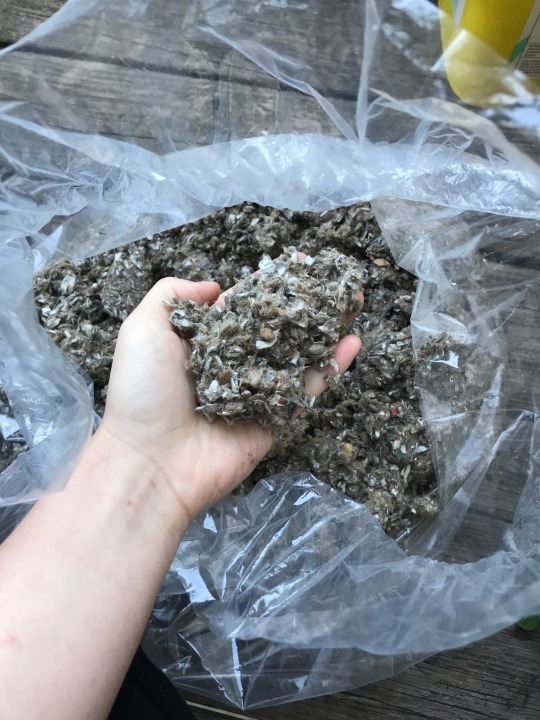
I’ve also tried using peat moss as bedding, but that didn’t work so well—I got a huge spike in the more population (maybe from acidic conditions?). Peat moss also isn’t great for the environment in general.
The bedding is important because worms shouldn’t eat too much food or too much of their own poop (castings) as both are bad for them. Bedding should be topped off when possible. When you add food to the bin, use a shovel to bury it in the bedding. This helps things rot properly, prevents mold and bad smells, and keeps away critters like fruit flies.
Other Critters
Your worm bin can and should have other critters in it! Some in my bin include mites and springtails, who both help the worms break down organic matter. However, there should be a balance between other critters and the worms. If something appears to be taking over, you might have a problem. I’ve also had fruit flies in my bin—this didn’t end up being a huge problem as long as I only opened the lid of the bin outdoors.
Worm Bin Maintenance
Once you get going, the worm bin doesn’t require much maintenance. I keep a freezer bag in my freezer and fill it up with food scraps, and once it seems the worms are mostly finished with the last feeding, I’ll thaw the bag and feed them again. (Freezing is helpful because it’s a convenient way to preserve the scraps, but it also helps to kickstart breaking down, since freezing damages things.) Be careful not to over-feed the worms, as this can lead to a sour bin and/or string-of-pearls (which is a pretty disturbing worm ailment).
Also be careful of what you feed the worms. You can look up lists of dos and donts online, but in general, stick to plant matter, and don’t feed them aromatic herbs or citrus. Also make sure to feed the worms plenty of crushed eggshells, as this provides grit and halos to regulate the pH of the worm bin.
The worms should be kept in a location with temperatures that are comfortable to humans. They don’t do well if conditions are too cold or too warm.
Make sure to dump out any water that accumulates and add bedding when it’s needed. I use this to water plants, and I haven’t had any negative effects, but some people will say you shouldn’t do that.
Once the bin starts to get full, you can remove worm castings. There are fancy ways to do this, but I just dig through the bin and scoop out any areas that are nearly all worm castings and then remove any worms/eggs that are in the castings by hand. The castings can be mixed in with potting soil or used on top like a mulch. (Although be careful: Ive heard worms are an invasive species in some areas so check before you potentially introduce them to the ground.)
Conclusions
So that’s it! If you want more information, I encourage you to do your own research. Although try to seek out multiple sources—not all the information out on the internet (or even in books) has been properly vetted. I can also try my best to answer questions based on my own experience, but I’m still relatively new at this.
47 notes
·
View notes
Text
red dwarf characters if they were. worms
lister: Microplana terrestris
rimmer: Erpobdella obscura
the cat: Hermodice carunculata
kryten: Eisenia fetida
kochanski: Australoplana sanguinea
thank you and good night.
10 notes
·
View notes
Note
what kind of wizardy can a worm do
a worm can do many wizardies, such as
turn gunk and shit into beautiful dirt
regenerate body parts (and even duplicate self, if you're very special like eisenia fetida)
create holes underground
absorb heavy metals
cast bioavailable nitrogen, potassium, and phosphates
parthenogenesis (or fuck nasty, they can do both)
#thanks for asking!#some gems from earthworm wikipedia include:#'the earthworm's existence cannot be taken for granted'#'for the 7 billion of us. each person alive today has support of 7 million earthworms'#apparently darwin wrote:#'it may be doubted whether there are many other animals which have played so important a part in the history of the world#as have these lowly organized creatures'
2 notes
·
View notes
Note
Alexander....... would you still love me if I was a Worm. 🥺
Hello Anon!
Oh, this was…. I, I must admit, I was not expecting this. What a fascinating question.
Well, Anon, I’ve no idea who you are, however, I’d like to imagine that we could get along quite nicely with you as a worm. Namely, you would not be able to speak, which would be a much appreciated respite from the daily earful I get from Natalie.
But here are my follow up questions: what kind of worm are we talking about? Are we going with Eisenia fetida, Lumbricus Linnaeus, or Clitellata Annelida?
Or are we talking something far more insidious like Acanthocephala or Taenia saginata?? Oh! Is this a trick question? Are you a malicious person who intends to become a malevolent parasite to feast on me?? In that case I would not like you one bit.
But let’s say for argument’s sake, you were a benevolent worm species. Would you still maintain the personal awareness and cognitive function of your former self or would you be just an unthinking, dull creature who wriggles in the ground? That certainly does not mean your life would be any less worthy or significant, I’m just wondering if we’d be able to communicate.
In any case, it might be quite fun to have a friend I could also wear as a boa. So, sure, let’s consider ourselves friends even in worm form, Anon!
Cheers!
Yours Truly,
Alexander
18 notes
·
View notes
Text
Taking Care of Business 2 – Back to Using Water
The undeniable advantages of a flush toilet
In my last post on humanure composting I described how human feces can be composted in a simple, cheap, and efficient way, and why it is less wasteful of water and nutrients than using a conventional flush toilet.
Now, I want to return to the idea of flushing down our human wastes with water. This is not playing devil's advocate, I simply want to look at all possible advantages of that system, to see how they can be utilized in a sustainable way. Also, certain people may have a hard time adjusting to a system they are not familiar with, no matter how efficient it may be. There's nothing to be ashamed of in this. We are toilet trained from an early age, and what we learn during that formative period tends to stay with us all our lives. A flush toilet may in fact constitute a psychological necessity. This need is also important and should not be ignored, especially since there are real, tangible upsides to flush toilets.
The biggest advantage of water is the perfect seal it forms, blocking any smell from whatever has passed the curve in the pipe. This fact alone may be important enough to consider a flush system, preferably the kind that won't waste our resources like our conventional system does.
Can a flush toilet actually be sustainable?
The two most important questions to ask in this regard are: Where does the water for our toilet come from, and where does it go from there? If its origin is a clean water source, such as wells or aquifers, or any elaborate, energy hungry, purifying system, I would deem the use of such system for flushing toilets criminal, to say the least. Using potable water to get rid of excrement while others are dying of thirst used to be punishable by death in many cultures. On the other hand, the flush toilet becomes more acceptable if the water has been used previously, at least a couple of times, as it happens in Earthships. There the water in the toilet has already been used twice: first to wash (hands, dishes, clothes, shower, etc.), then to water plants in the gray-water planter in the greenhouse.
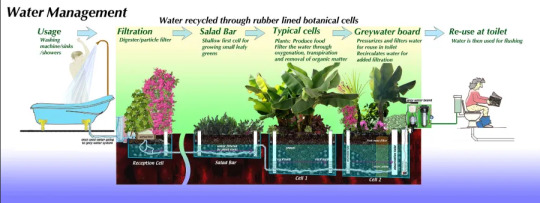
image source
No Earthship? No problem!
Earthships are amazing at catching water, filtering it, using and reusing it, and still re-reusing it further. But what if we don't happen to be living in such a well designed structure? We can still use the water at least once, before flushing it down the toilet. For example, in one of the most common activities linked with the toilet: washing our hands. Japanese toilets have been famous for these kinds of features, but the same idea can be implemented with locally available materials. The picture on the right is my first attempt at this in our Mexican apartment.

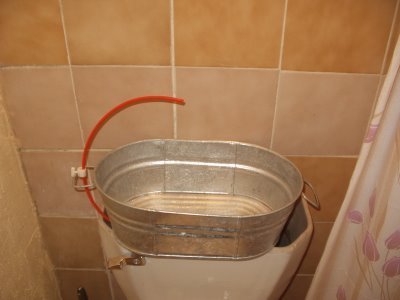
The other question regarding the water's final destination is equally important. Since there is no “out” or “away” where you could throw it, another option must be sought. Can humanure in water be composted? It sure can, once it has been removed from the water. Red compost worms (Eisenia fetida) do an amazing job at it. In one place in New Zealand I had the pleasure to help set up such as system. Inside of the house were a seemingly standard bathroom with a flush toilet and a kitchen with a garbage disposer in the sink. Both drained into the same bin behind the house, a concrete basin of 180x60cm, with a depth of 70cm (6 x 2 x 2.3 feet). In the bottom we laid a loop of drainage pipe, leading out through the drainage hole of the basin, and covered it all with gravel. On top of the layer of gravel we suspended a mesh basket. This is where the solids will remain, and where the worms live. The water drains away immediately while the solids remain, feeding the worms. When the basket is full of compost it can be lifted out and emptied, something we estimated to happen every 1-2 years. Meanwhile, the occupant of the house could enjoy full western comfort in kitchen and bathroom, while knowing that their resources won’t be wasted.
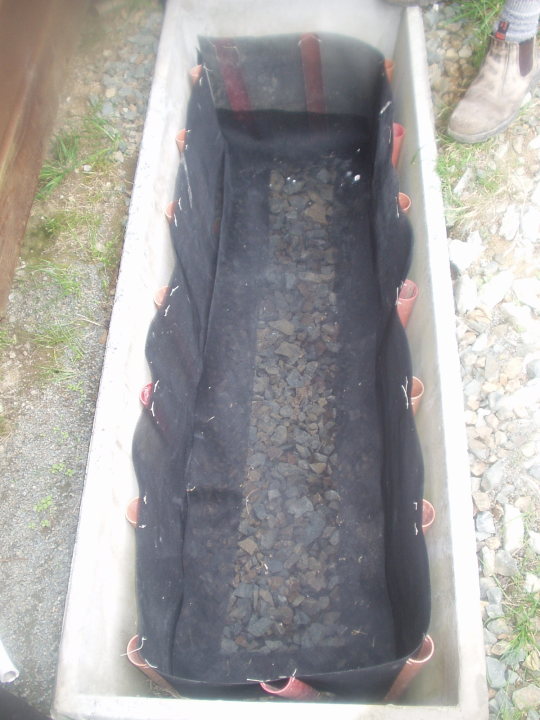

But what happens to the water?
Once it has left the worm-bin, the water flows through a series of basins. The first one is a filtration tank, with layers of bark, scoria, sand, and charcoal. The next step after this tank is the 97 liter (26 gallon) dosing chamber. This feature of the system ensures that when water enters the soakage trench, it spreads out evenly. Without the dosing chamber the water would dribble little by little, every time the facilities are being used, without much pressure, and accumulate in the lowest section of the trench. However, if everything is flushed at once, the entire pipe fills up evenly. This type of dosing chamber works with a pressure siphon. The lack of moving parts guarantees the low maintenance aspect.

Eventually the water drains down the hill into the pipe inside the trench. The trench is 50 meters (164 feet) long, following the contour line of the hill. Around the pipe the trench is filled with more scoria as well as charcoal. This will soak up the water as soon as it comes out of the pipe, and more microorganisms can feed on it. A bit further down the hill a line of citrus trees make use of the water that passes onward through the trench. Still further down the hill, once it has passed through the filter, the trench, and the orchard, the water goes into a pond. A red aquatic weed grows on the surface, which can be skimmed off and used in the garden. It is very rich in nutrients and can be either dried, used as mulch, or mixed into the soil. In any case, it returns the excess nutrients back into the food circle, allowing us to eat our own wastes in form of healthy, tasty, nutritious food.
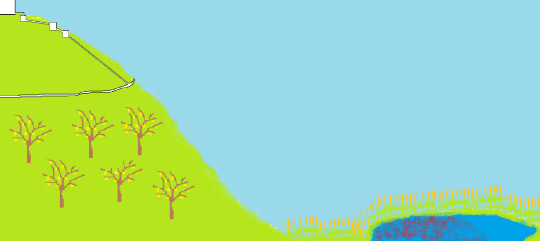
Other possibilities?
Yet another system I have seen doesn't even need a hill to flush and spread out the water. The concept is quite similar: Nutrient-rich blackwater from the toilet goes into an 'infiltrator', an inverted half-pipe buried underground, with about 60 cm (2 feet) of pumice or scoria under, around, and above it. This buried dome is empty inside, that's where all the water from the house drains into. The water seeps down, into the many tiny pockets in the volcanic rock, where microorganisms get to compost it. Fruit trees are planted all around the infiltrator, and sunflowers on top of it. Their roots reach around and under the half-pipe, taking up the water and the nutrients.
Design for the proper scale
With so many ways to utilize the nutrients from human wastes, whether with or without water, there really should not be an excuse for not composting humanure. No matter which option we go with, it's always important to design the system at the right scale: don't make it too small, which can be quickly overwhelmed by a sudden peak of visitors, but don't make it too large either, which would leave its dependents (worms, trees, etc.) without the water and nutrients they need. Most importantly, make sure all the water you use is taken up, to avoid ground-water contamination, as it is often the case for old-style outhouses.
sources: 1, 2, 3, 4, 5
4 notes
·
View notes
Text
Lombricultura con pan duro.
youtube
#bioabonos#lombricompostaje#reciclaje#huerta#agricultura#Eisenia fetida#lombriz#lombriz californiana#Youtube
1 note
·
View note
Text
Toprak Solucanlarını Sınıflandırma Terimleri Üzerine Bir Değerlendirme
Toprak Solucanlarını Sınıflandırma Terimleri Üzerine Bir Değerlendirme
#Anecic, #AnecicSolucanlar, #AnecicSolucanlarTürkçe, #Endogeic, #EndogeicSolucanlar, #EndogeicSolucanlarTürkçe, #Epigeic, #EpigeicSolucanlar, #EpigeicSolucanlarTürkçe, #Solucanlar, #ToprakBiyolojisi, #ToprakEkosistemi, #ToprakIşleyenCanlılar, #ToprakSolucanı, #ToprakSolucanlarıAraştırmaları, #ToprakSolucanlarıEkolojikSınıflandırma, #ToprakSolucanlarıEkosistemHizmetleri, #ToprakSolucanlarıSınıflandırması, #ToprakSolucanlarıTerminolojisi, #ToprakSolucanlarıTürkiye, #ToprakSolucanlarıVeBiyoçeşitlilik, #ToprakSolucanlarıVeÇevre, #ToprakSolucanlarıVeEkosistem, #ToprakSolucanlarıVeEkosistemDinamikleri, #ToprakSolucanlarıVeTarım, #ToprakSolucanlarıVeToprakKalitesi, #ToprakSolucanlarıVeToprakSağlığı, #ToprakSolucanlarınınEkolojikRolü, #ToprakSolucanlarınınEtkileri, #ToprakSolucanlarınınÖnemi, #YeraltıCanlıları, #YeraltıEkolojisi, #YeraltıFaunası https://is.gd/S0Czfy https://www.tibbivearomatikbitkiler.com/makaleler/toprak-solucanlarini-siniflandirma-terimleri-uzerine-bir-degerlendirme/
Toprak solucanlarını sınıflandırma, toprak solucanlarını toprak içindeki faaliyetlerine ve buna bağlı olarak da toprak içinde ve üzerinde bulunuşlarına göre “epigeic”, “endogeic” ve “anecic” terimleri kullanılarak sınıflandırılmaktadır. Bu çalışmada; solucanların topraktaki işlevlerinden ve ekofizyolojik özelliklerinden yola çıkılarak topraktaki bulunuş yerlerine ait muhtemel birer Türkçe karşılık oluşturulmaya çalışılması ve bilim yazınına sunulması hedeflenmiştir. Elde edilen sonuçlar çizelge 4 ve 5’te toplu olarak sunulmuştur. Varılan bu karşılıkların solucanlar da dâhil olmak üzere toprakta bu tür faaliyet gösteren diğer canlı gruplarının isimlendirilmesinde de faydalı bir esin kaynağı ve dayanak oluşturması temenni edilmektedir.
Toprak Solucanlarını Sınıflandırma Terimleri Üzerine Bir Değerlendirme – Giriş
Toprak solucanları toprağı iyi bir şekilde işleyen canlılar olarak bilinmektedir. İçinde bulundukları ekosistem üzerinde pek çok yönden belirleyici bir işleve sahiptirler. Bunların başında toprağın pH’sı üzerindeki etkileri gelmektedir. Nitekim solunum sistemlerinin çalışma prensibi itibariyle (Robertson 1936) toprakta kalsiyum karbonat olarak bilinen kalsitlerin (CaCO3) miktarını arttırarak toprağın pH’sı üzerinde asitliği tamponlayıcı yönde bir etkiye sahiptir (Lambkin ve ark. 2011). Toprak solucanlarının toprak üzerinde olumlu etkileri olduğuna dair genel bir kanı bulunmakla birlikte, istilâcı olan türleri toprak üzerindeki organik maddeyi yiyerek doğrudan ölü örtünün azalmasına, Ahorizonunun kalınlaşmasına ve gençliğin çimlenmesi için gerekli ortamın kalitesinin düşmesine yol açarak ormanların geleceğini tehdit edebilmektedirler (Hale ve ark. 2008, Görres ve Melnichuk 2012). Solucanlar oluşturdukları kanal sisteminde diğer mikro canlılar için de uygun bir yaşama ortamı sağlayarak bir çeşit besin adaları oluştururlar (Savin ve ark. 2004).
Toprak solucanları üç ana ekofizyolojik grupta bulunmaktadır: (ı) ölü örtü ve/veya kompostları yiyen “epigeic” solucanlar, örneğin; Eisenia fetida (foetida); (ıı) üst toprak veya orta derinlikteki topraklarda yaşayan “endogeic” solucanlar, örneğin; Allolobophora caliginosa (ııı) toprağın 50-150 cm derinliklerine kadar kalıcı olarak kanallar açan ve zaman zaman da yaprak veya besin
maddesi olabilecek bitkisel artıklara ulaşmak için yüzeye çıkan “anecic” solucanlar; örneğin; Lumbricus terrestris grupları vardır (Şekil 1) (Edwards ve ark. 2011).
Türkçe bilim dilinin son yıllarda yaşadığı önemli sorunlardan birisi de yabancı dilde üretilen terimlerin bu çalışmanın konusunu oluşturan terimlerde olduğu gibi zaman zaman Türkçe okunuş şeklinde(Sevgi 2004) veya tıpkı yazımı şeklinde alınması olmaktadır. Bu durum hem bilim insanlarının birbirleri arasındaki, hem bilim insanları ile toplum arasındaki ve hem de eğitim sürecinde bilim insanları ile öğrenciler arasındaki iletişimin kalitesini düşürmektedir. Yabancı dildeki terimlerin Türkçeye aktarılması sırasında yaşanan sorunlar daha önce çok daha ayrıntılı bir
biçimde ele alınmıştır (Sevgi ve Tecimen 2008). Bu çalışmada da aynı hassasiyetin bir uzantısı olarak yukarıda da italik olarak verilmiş olan “epigeic”, “endogeic” ve “anecic” kelimeleri için Türkçe karşılık üretilmesi gayreti hedeflenmektedir.
Bu çalışmada; solucanların yukarıda bahsedilen işlevlerinden ve ekofizyolojik özelliklerinden yola çıkılarak solucanların topraktaki bulunuş yerlerine ait muhtemel birer Türkçe karşılık oluşturulmaya çalışılması ve bilim yazınına sunulması hedeflenmektedir. Çalışmamızın sonucu olarak önerilen terimler değiştirilemez olmayıp öncelikle bir öneri niteliği taşımaktadır.
Toprak Solucanlarını Sınıflandırma Terimleri Üzerine Bir Değerlendirme – Yöntem
Doğrudan toprak solucanları ile ilgili olarak Türkçe yazılmış bilimsel makaleler ve tek kitap olan “Toprak Solucanları Biyolojileri, Ekolojileri ve Türkiye Türleri” (Mısırlıoğlu 2011) kaynakları incelenerek bu kaynaklarda ilgili sınıflandırma terimleri taranmış ve karşılaştırılmıştır. Solucanların ekolojisi üzerine yapılan çalışmalardan alıntılar aynen aktarılarak ve Türkçeye çevrilerek bulgular bölümünde sunulmuş ve tanımların ışığında Türkçedeki uygun karşılıklar hakkında irdeleme yapılmıştır. Sınıflandırma için kullanılan kelimelerin Latinceden / Yunancadan alınan kökleri ve kısımları incelenerek Türkçede olabilecek en doğru karşılık aranmaya çalışılmıştır.
Toprak Solucanlarını Sınıflandırma Terimleri Üzerine Bir Değerlendirme – Bulgular
“Epigeic” kelimesi Brady ve Weil (2008) tarafından “the relatively small epigeic earthworms live in the litter layer or in the organic-rich soil very near the surface. Epigeic earthworms, which include the common compost worm, Eisenia foetida hasten decomposition of the litter but do not mix it into the mineral soil.” olarak tanımlanmıştır. Bu tanıma istinaden Brady ve Weil’e (2008) göre “epigeic” solucanlar “Nispeten küçük solucanlar olup ölü örtü içinde veya yüzeye çok yakın organik maddece zengin toprak içinde yaşamaktadır. Pek çoğu örneğin Eisenia foetida gibi kompost solucanlarındandır ve bunlar ölü örtünün ayrışmasını hızlandırırlar ancak toprağa karıştırılmasında rol oynamazlar” denilmektedir. “Endogeic” türler Brady ve Weil (2008)’e göre “endogeic earthworms, such as the pale, pink Allolobophora caliginosa (known as red worm) live mainly in the upper 10 to 30 cm of mineral soil where they make shallow, largely horizontal burrows.” olarak tanımlanmıştır. Bu tanımdan da anlaşılacağı üzere Brady ve Neil’e (2008) göre “endogeic” türler soluk pembe bir tür olan Allolobophora caliginosa (kırmızı solucan olarak bilinmektedir) gibi mineral toprak içinde yüzeyden 10-30 cm derinlikte yaşarlar ve sığ ve çoğunlukla yatay tüneller açmaktadırlar. “Anecic” türleri için ise Brady ve Weil (2008)’de “the relatively large anecic earthworms make vertical, relatively permanent burrows, often covering the entrance to their burrow with a midden of leaves.” olarak tanımlanmıştır. “Anecic” türleri tanımlayan Brady ve Weil (2008) bu solucan türlerinin daha büyük boyutlarda olduğunu, düşey ve nispeten kalıcı tüneller açtıklarını ve tünellerinin ağızlarını genellikle öğütülmüş yapraklarla kapattıklarını
belirtmişlerdir. “Anecic” türler için Görres ve ark. (2001) da yarı-kalıcı tüneller oluşturduklarını kaydetmiştir. Bouché’nin (1972) yaptığı gözlemlere göre solucanların birbirinden ayrılan belirgin morfolojik (dışyapısal) ve ekofizyolojik (çevreye bağlı değişen vücut işlevleri) özellikleri bulunmaktadır (Çizelge 1)
Bailey’den (1999) alınan Yunanca ve Latince kökler listesinden elde edilen bilgilere göre “epigeic”, “endogeic” ve “anecic” kelimelerini oluşturan kökler aşağıdaki gibidir (Çizelge 2). Stearn (1983) de Bailey (1999)’a paralel olarak “epi-“ ön ekinin Yunancada “üstüne, üstünde” anlamında ve “endo-“ önekinin “içinde” anlamında kullanıldığını belirtmiştir.
Şekil 1. Toprak solucanlarının bulundukları derinlik ve tünel özelliklerine göre sınıflandırılması (Anon. 2013).
Çizelge 1. Toprak solucanlarının bazı morfolojik ve ekofizyolojik özellikleri (Bouché 1972)
Çizelge 2. İngilizce köklerin anlamları, etimolojisi ve bazı örnekler (Bailey 1999)
Türkçe kaynaklarda ise bazen Aydın (2006) gibi bir kaynağa atıf yapmaksızın toprak solucanlarının derinliğe göre bir sınıflandırması yapılmış, bazen de Mısırlıoğlu (2011) gibi atıf yapılarak tanımlama yapılmıştır. Aydın (2006) toprak solucanlarının ekolojik sınıflandırmalarında kullanılan terimleri “Toprak solucanları, ekolojik yönden bulundukları katmanlara göre; epijeik, endojeik ve anesik olmak üzere üç grupta toplanır. Epijeik türler yüzeye yakın; endojeik türler daha altta, mineral toprak katmanında ve anesik türler ise daha derin toprak katmanında yaşarlar. Epijeik türler genellikle yüzeydeki bitki artıklarıyla beslendiklerinden; kirleticiler endojeik türlerde epijeik türlere göre daha yoğun düzeyde bulunur” kullanmış ancak bu terimleri İngilizce okunuşlarıyla kullanmıştır. Mısırlıoğlu (2011) Bouché’ye (1972) atfen solucanların topraktaki yaşam katmanları başlığı altında “epijeik” türlerin mineral tabakanın üzerinde yüzeye yakın yaşadığını ve yüzey
organik maddeleriyle beslendiğini, “endojeik” türlerin mineral toprak horizonunda (üstten 20 cm) yaşayan türler olduğunu ve “anesik” türlerin derin galeri açan türler olduğunu ve ancak bunların da yine yüzey organik maddeleriyle beslendiğini belirtmiştir. Mısırlıoğlu (2011) yine aynı eserinde toprak katmanlarından ayrı olarak boyutları bakımından da toprak solucanları hakkında bir
değerlendirme yapmış ve büyük türlerin (örneğin Lumbricus terrestris) “anesik” ve küçük türlerin ise “epijeik” ve “endojeik” olduğunu bildirmiştir.
Toprak Solucanlarını Sınıflandırma Terimleri Üzerine Bir Değerlendirme – Tartışma ve Sonuç
Yıldız ve ark. (2005) tarımsal bitki ve hayvan öldürücü ilaçların etkilerini inceledikleri yayınlarında toprak solucanlarından ve etkilerinden bahsederken bulundukları toprak ortamını “özellikle besin maddesince zengin olan toprağın 30-45 cm derinliklerinde bulunur” solucanların ekolojik sınıflandırmalarında kullanılan isimleri yerine doğrudan metrik bir derinlikle ifade etmişlerdir. Çakır ve Makineci (2011) solucanları işlevleri açısından değerlendirirken “ekosistem mühendisleri” olarak tanımlamışlardır. Az da olsa yazılmış bulunan Türkçe kaynaklarda da görüldüğü üzere bazı yazarlar başta Mısırlıoğlu (2011) olmak üzere yabancı dilden terimlerin aktarılması sırasında çoğunlukla başvurulan okunuşunu yazma yöntemini kullanmış, bir kısmı ise bu terimleri hiç
kullanmadan doğrudan yaklaşık bir derinlik kademesi vererek bu sınıflandırma özelliklerini ve solucanların işlevlerini derinlemesine ele almaktan kaçınmıştır (Yıldız ve ark. 2005). Bunun nedeni çalışmanın ana konusunun doğrudan solucanlar üzerine olmaması olabilir.
Ancak, Türkçede bu konunun işleniş biçimlerinden örnekler sunması bakımından bu yayınlar tartışma konusu edilmeye değer bulunmuştur. Kelimelerin köklerinden ve kök anlamlarından
yola çıkılacak olursa harfi harfine kök ve ekler bir araya getirildiğinde Türkçe dilinin yapısı, estetiği ve kelimelerin işlerliği bakımından pürüzler içeren sonuçlar elde edilmektedir (Çizelge 2 ve 3). Şöyle ki; “epigeic” terimi için: üst-(epi: upon > üst) – Kara, yer, toprak (geo: earth > Kara, yer, toprak) yapılarından: üstkara / üstyer / üsttoprak “endogeic” terimi için: iç-(endo: in > iç) – Kara, yer, toprak (geo: earth > Kara, yer, toprak) yapılarından: içkara / içyer / içtoprak ve “anecic” terimi için: Hariç / değil / dışında / -sız -(an: not > Hariç, değil, dışında, -sız) –ev (eco: home > ev) yapılarından (en uygununu oluşturacak olursak): dışev sonucuna ulaşılmaktadır.
Çizelge 3. Köklerin orijinal anlamlarından yola çıkılarak üretilen karşılıklar
Takdir edilir ki; Türkçenin dil yapısı bu şekilde işlememektedir ve kelimelerin oluşumunda eylemler veya anlamlar kökte yer almakta, tanımlayıcı ekler ise sona gelmektedir. Büyükkantarcıoğlu’nun da (2000) bildirdiği gibi “Geleneksel sözcük çekimi modeli, özellikle Latince ya da eski Grekçe gibi iç-bükümlü dillerde sözcüğün durumlara göre çekim paradigmalarını ele aldığı için sözcüğü temel birim olarak tanımlamıştır. Oysa üretimsel dilbilgisinde sözcüğün temel alınmasının nedeni, dilde ek-kök bileşmelerinin amacının sözcük oluşturması ve bu süreçte de dilsel yetinin önemli bir rol oynaması” önemli olmaktadır. Ayrıca “…öncelik-sonralık kurallarına ve sesdizimsel ve sözdizimsel beklentilere uyulmadığı zaman, ortaya çıkan biçimbilimsel
yapılar dilbilgisel olmamaktadır. … sözcük, ister türetim, ister çekim ekleri ile, isterse de var olan biçime yeni anlam yüklemeleriyle oluşmuş bir sözcük (semantic neologism) olsun oluşumu ve kullanımı içinde dilin tüm kurallarına uygunluk göstermek zorundadır.” ilkeleri de göz önüne alındığında oluşturulan “üstkara / üstyer / üsttoprak”, “içkara / içyer / içtoprak” ve “dışev” terimleri bu kuralların dikte ettiği unsurları tümüyle yansıtmamaktadır.
Türkçenin yapısına daha uygun olması ve toprak biliminde kullanılan kulağa daha aşina gelebilecek terimlerin oluşturulması sonucu aşağıdaki (Çizelge 4) seçeneklere ulaşmak mümkündür.
Bunların dışında Bouché (1972)’de verilen bazı morfolojik ve eko-fizyolojik özellikler ve Brady ve Weil (2008)’deki tanımlarla birleştirilerek ele alındığında ilgili terimlere uygun karşılıklar üretmek bakımından çizelge 5’teki seçenekler öne çıkmaktadır.
Sonuç olarak, incelenen terimlere Çizelge 4 ve 5’te bazı karşılıklar önerilmiş ve toprak solucanı ve terim uzmanlarının dikkatine sunulmuştur. Solucanlar üzerine yapılan çalışmalar ve ilgi arttıkça bu terimleri kullanması ve yenilerinin üretilmesi ihtiyacı daha da artacaktır. Bu çalışmanın solucanlar da dâhil olmak üzere toprakta bu tür faaliyet gösteren diğer canlı gruplarının isimlendirilmesinde de faydalı bir esin kaynağı ve dayanak oluşturması temenni edilmektedir.
#anecic#anecic solucanlar#anecic solucanlar Türkçe#endogeic#endogeic solucanlar#endogeic solucanlar Türkçe#epigeic#epigeic solucanlar#epigeic solucanlar Türkçe#solucanlar#toprak biyolojisi#toprak ekosistemi#toprak işleyen canlılar#Toprak solucanı#toprak solucanları araştırmaları#toprak solucanları ekolojik sınıflandırma#toprak solucanları ekosistem hizmetleri#toprak solucanları sınıflandırması#toprak solucanları terminolojisi#toprak solucanları Türkiye#toprak solucanları ve biyoçeşitlilik#toprak solucanları ve çevre#toprak solucanları ve ekosistem#toprak solucanları ve ekosistem dinamikleri#toprak solucanları ve tarım#toprak solucanları ve toprak kalitesi#toprak solucanları ve toprak sağlığı#toprak solucanlarının ekolojik rolü#toprak solucanlarının etkileri#toprak solucanlarının önemi
0 notes
Text
Buy Vermicompost in India: Choosing the Best Manufacturer
Buy Vermicompost in India: Choosing the Best Manufacturer
February 26, 2024
Vermicompost, also known as worm compost, is a nutrient-rich organic fertilizer produced through the process of vermicomposting. It is a natural and sustainable alternative to chemical fertilizers, offering numerous benefits to both plants and the environment.
Importance of Vermicompost
Best Vermicompost manufacturer in India is highly regarded for its ability to improve soil structure, increase nutrient availability, and enhance plant growth. Unlike synthetic fertilizers, vermicompost enriches the soil with organic matter, promoting soil health and microbial activity.
Understanding Vermicomposting Process
The success of vermicomposting relies on the selection of the right type of worms, typically red wigglers (Eisenia fetida) or red earthworms (Lumbricus rubellus). These worms are voracious eaters and efficient decomposers of organic matter. Various organic materials can be used for vermicomposting, including kitchen scraps, garden waste, and agricultural residues. It's essential to avoid acidic or toxic materials and maintain a balanced diet for the worms. A well-designed vermicomposting bin provides optimal conditions for the worms to thrive. It should be well-ventilated, moisture-retentive, and spacious enough to accommodate the organic waste. Layering bedding materials like shredded paper or cardboard creates a conducive environment for decomposition.
Benefits of Using Vermicompost
Vermicompost improves soil fertility by enhancing its structure, moisture retention, and nutrient content. It releases nutrients gradually, providing a sustained source of nourishment for plants. Plants grown in soil amended with vermicompost exhibit stronger root systems, increased resistance to diseases, and higher yields. Best Vermicompost manufacturer promotes balanced growth and development, leading to healthier and more vibrant plants. By recycling organic waste into valuable fertilizer, vermicomposting reduces the burden on landfills and minimizes greenhouse gas emissions. It fosters a circular economy where waste is transformed into a valuable resource, contributing to environmental sustainability.
Factors to Consider When Buying Vermicompost
Quality vermicompost should have a dark, crumbly texture and a pleasant earthy smell. It should be free from contaminants and pathogens, ensuring safe and effective use in gardening and agriculture. While price is a consideration, it's essential to prioritize quality over cost when purchasing vermicompost. Investing in premium-grade vermicompost yields better results and long-term benefits for soil health and plant growth. Choosing a reputable best vermicompost manufacturer ensures product consistency, reliability, and customer satisfaction. Researching customer reviews and testimonials can help assess the manufacturer's reputation and credibility.
Best Vermicompost Manufacturers in India
India boasts several renowned vermicompost manufacturers in India known for their high-quality products and commitment to sustainability. When selecting a manufacturer, consider factors such as product quality, pricing, and customer service.
Best Vermicompost Manufacturer in Punjab
Best vermicompost manufacturer in Punjab, with its fertile agricultural lands, plays a significant role in vermicompost production in India. Several manufacturers in Punjab stand out for their excellence in vermicompost production and distribution.
Conclusion
In conclusion, vermicompost is a valuable organic fertilizer that offers numerous benefits for soil health, plant growth, and environmental sustainability. By choosing the best vermicompost manufacturer in India, gardeners and farmers can harness the power of vermicompost to enrich their soils and cultivate thriving gardens and crops.
FAQs (Frequently Asked Questions)
Is vermicompost suitable for all types of plants?Vermicompost is beneficial for a wide range of plants, including vegetables, fruits, flowers, and ornamentals. It enhances soil fertility and promotes healthy growth regardless of plant species.
How often should vermicompost be applied to the soil?Vermicompost can be applied to the soil as a top dressing or incorporated during planting. For best results, apply vermicompost once or twice a year, depending on the specific needs of the plants and soil conditions.
Can vermicompost be used as a potting mix?Yes, vermicompost can be mixed with potting soil or used as a component of homemade potting mixes. Its nutrient-rich composition improves soil structure and provides essential nutrients for potted plants.
Is vermicompost safe for organic gardening?Absolutely! Vermicompost is a natural and organic fertilizer produced from decomposed organic matter. It is free from synthetic chemicals and harmful additives, making it safe for organic gardening practices.
How long does it take to produce vermicompost?The vermicomposting process typically takes 2 to 6 months, depending on factors such as temperature, moisture levels, and the size of the composting system. With proper management, worms can efficiently con
#buy vermicompost in india#best vermicompost manufacturer#best vermicompost manufacturer in punjab#best vermicompost manufacturer in india
0 notes
Text
Earthworms vs. Compost Worms: Unraveling the Distinctive Traits
When we think of worms, the image that typically comes to mind is a long, slender creature wriggling through the soil. However, not all worms are created equal. Two common types of worms that often get confused are earthworms and compost worms. While they may seem similar at first glance, there are several distinctive traits that set them apart.
Earthworms: The Gardeners' Friends
Earthworms, also known as nightcrawlers, are the unsung heroes of the garden. These earth-dwelling creatures play a vital role in maintaining soil health and fertility. Earthworms are typically larger and more robust than compost worms, often reaching lengths of up to a foot. They have a brownish-red coloration and a cylindrical body. Their burrowing habits create channels in the soil, which improve aeration and water infiltration. This is why they are considered a gardener's best friend.
Compost Worms: The Decomposers
Compost worms, on the other hand, are smaller and specialize in breaking down organic matter. These worms, such as red wigglers (Eisenia fetida) and European nightcrawlers (Eisenia hortensis), are often the stars of vermicomposting systems. They have a slender, reddish appearance, and they excel at consuming kitchen scraps and other organic materials, turning them into nutrient-rich compost. Compost worms are typically not as large as earthworms, reaching lengths of only a few inches.
Dietary Differences
One of the most significant difference between similar terms of worms is their diet. Earthworms primarily feed on soil and decaying plant matter. Their diet consists of mineral-rich soil, making them excellent soil aerators and nutrient cyclers. In contrast, compost worms are voracious consumers of organic materials, such as fruit and vegetable scraps, coffee grounds, and even cardboard. They excel at breaking down these materials, converting them into vermicompost, which is a valuable addition to garden soil.

Habitat Preferences
Earthworms and compost worms also have distinct habitat preferences. Earthworms are typically found in garden beds, lawns, and other natural soil environments. They are well-suited for large-scale soil improvement projects. Compost worms, on the other hand, thrive in controlled environments like worm bins and compost piles. Their ability to tolerate confined spaces and high population densities makes them ideal for small-scale composting operations.
Lifecycle and Reproduction
Both earthworms and compost worms have similar reproductive strategies. They are hermaphrodites, possessing both male and female reproductive organs. However, earthworms and compost worms have different reproductive rates. Earthworms reproduce more slowly, with fewer offspring, while compost worms reproduce more rapidly and have a higher population turnover.
In conclusion, while earthworms and compost worms share a few similarities, they have distinctive traits that set them apart. Earthworms are soil-dwellers, with larger bodies, feeding on mineral-rich soil. Compost worms, on the other hand, excel at breaking down organic matter and are typically found in controlled composting environments. Understanding these differences is crucial for gardeners, composters, and anyone interested in the role of these fascinating creatures in soil health and waste reduction. Whether you're nurturing your garden or reducing your ecological footprint through composting, knowing the unique traits of earthworms and compost worms can help you make the most of their contributions to your endeavors.
0 notes
Text
The Battle Beneath Our Feet: Worms in Lawns and the Secrets of Adenium Obesum, Woolly Aphids, and Snowdrift Crabapple
Your lawn, that lush expanse of green, might seem like an oasis of serenity, but beneath the surface, a complex ecosystem is at play. Earthworms, those unassuming wrigglers, are a vital part of this ecosystem, contributing to soil health and the overall well-being of your lawn. However, there's more to this story than meets the eye. In this extensive exploration, we'll unearth the fascinating world of worms in lawns, delve into the intriguing realm of the Adenium Obesum, encounter the curious woolly aphids, and appreciate the beauty of the Snowdrift Crabapple tree.
Worms in Lawns - Nature's Unsung Heroes
The Role of Earthworms
Let's begin our journey by getting to know the earthworms in your lawn. Earthworms, often taken for granted, play a crucial role in maintaining soil health. Here's why they deserve more recognition:
Soil Aeration: Earthworms create tunnels in the soil, which enhances aeration. This allows for better water infiltration and root growth.
Nutrient Recycling: They ingest organic matter like leaves and decaying plant material and convert it into nutrient-rich castings, improving soil fertility.
Improved Drainage: Earthworm burrows act as channels for excess water to flow through, reducing the risk of waterlogging.
Mixing Soil Layers: Worms help mix different soil layers, promoting a more balanced distribution of nutrients.
Indicator of Soil Health: The presence of earthworms is often an indicator of healthy soil. Their absence may signal soil degradation.
Common Types of Earthworms
Several species of earthworms are found in lawns, with the most common being:
Lumbricus terrestris: Known as the common earthworm, this species is often found in gardens and lawns. It's a deep-burrowing worm that contributes significantly to soil aeration.
Eisenia fetida: Also called the red wiggler or compost worm, this species is excellent for composting and breaking down organic matter.
The Worm's Lifecycle
Understanding the lifecycle of earthworms can shed light on their importance:
Egg: Earthworms start as eggs, which are cocoon-shaped and contain multiple embryos.
Juvenile Stage: After hatching, they go through juvenile stages, gradually increasing in size.
Mature Adult: Adult earthworms are the most active and contribute most to soil health.
Cocoon Production: Mature worms produce cocoons, each containing several eggs. These cocoons hatch to start the cycle anew.
The Allure of Adenium Obesum
Introduction to Adenium Obesum
Shifting our focus from below the ground to above it, we encounter the Adenium Obesum, a remarkable succulent also known as the Desert Rose. Here's what you need to know about this captivating plant:
Origins: Native to arid regions of Africa and the Arabian Peninsula, Adenium Obesum has adapted to thrive in dry, hot climates.
Appearance: Its thick, swollen trunk and striking pink or red flowers make it a favorite among succulent enthusiasts.
Cultural Significance: Adenium Obesum holds cultural significance in various regions, often associated with myths and legends.
Growing and Caring for Adenium Obesum
If you're considering cultivating this stunning succulent, follow these care guidelines:
Light: Provide ample sunlight, as Adenium Obesum thrives in full sun conditions.
Soil: Use a well-draining soil mix to prevent root rot.
Watering: Allow the soil to dry out between waterings to avoid overwatering, which can be detrimental.
Pruning: Prune the plant to encourage branching and a more compact growth habit.
Pests and Diseases: Be vigilant for pests like aphids and mealybugs, which can harm the plant.
Woolly Aphids - Nature's Tiny Villains
Meet the Woolly Aphids
While we're discussing pests, let's talk about woolly aphids, those peculiar insects that have a knack for infesting various plants, including the Adenium Obesum:
Appearance: Woolly aphids are tiny, pear-shaped insects covered in a white, wool-like substance, which acts as protection against predators.
Feeding Habits: They feed on plant sap by piercing the plant's tissues with their needle-like mouthparts.
Damage: Woolly aphids can weaken plants and cause stunted growth, leaf curling, and yellowing.
Secret Life: These aphids often go unnoticed due to their cryptic appearance, making them a hidden threat.
Managing Woolly Aphid Infestations
If you suspect woolly aphids have invaded your plants, here are some strategies for control:
Pruning: Remove heavily infested plant parts to reduce the aphid population.
Natural Predators: Encourage beneficial insects like ladybugs and lacewings, which feed on aphids.
Insecticidal Soap: Consider using insecticidal soap or neem oil to control aphid populations.
Regular Inspection: Conduct routine inspections of your plants to catch infestations early.
Snowdrift Crabapple - An Ornamental Treasure
Introduction to Snowdrift Crabapple
In our final chapter, we turn our attention to the Snowdrift Crabapple, a deciduous tree that graces gardens with its stunning appearance:
Botanical Name: Malus 'Snowdrift'
Appearance: Snowdrift Crabapple produces abundant clusters of fragrant white blossoms in the spring, resembling a snowdrift.
Fruit: It bears small, red crabapples that persist through the fall, providing visual interest and serving as a food source for wildlife.
Ornamental Value: This tree is prized for its ornamental value and is often used as a focal point in gardens.
Snowdrift Crabapple Care
To maintain the health and beauty of your Snowdrift Crabapple tree, follow these care tips:
Sunlight: Plant it in full sun to encourage abundant flowering.
Pruning: Prune in late winter to remove dead or diseased branches and maintain a pleasing shape.
Fertilization: Apply a balanced fertilizer in the spring to promote growth and blooming.
Pest and Disease Control: Keep an eye out for common crabapple pests and diseases, such as apple scab, and take appropriate measures for prevention.
Conclusion - A Tapestry of Natural Wonders
In the vast tapestry of nature, even the most seemingly insignificant creatures, like earthworms and woolly aphids, play vital roles. Likewise, the Adenium Obesum and Snowdrift Crabapple grace our lives with their beauty and resilience. As we explore these interconnected worlds of worms in lawns, succulent secrets, tiny villains, and ornamental treasures, we gain a deeper appreciation for the wonders that surround us, both above and below the ground. So, whether you're tending to your lawn, nurturing your Desert Rose, battling woolly aphids, or admiring the blossoms of a Snowdrift Crabapple, remember that each of these elements contributes to the intricate balance of our natural world.
0 notes